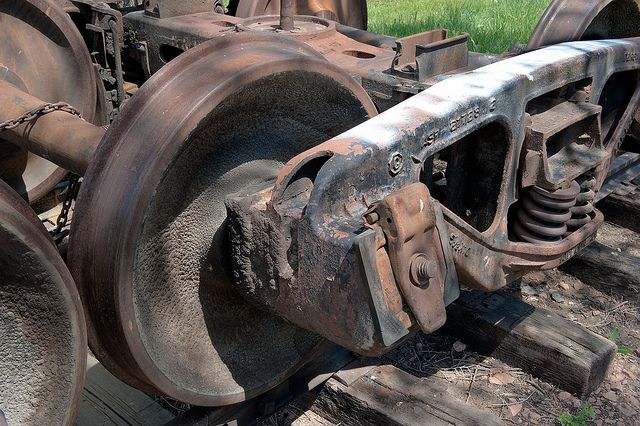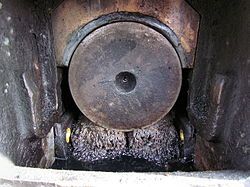Cabooses, Journal Boxes, why we did shove on or not shove against a Caboose. in Tales of the Jointed Track
- Aug. 21, 2014, 4:21 p.m.
- |
- Public
The question arose.. I understood most of this, but why or what conditions, you could or wouldn't shove against a Caboose?
There are many factors.
- One is, is it a roller bearing or a friction bearing.
- Two, are there lock blocks, or a restricting device to keep the draw bar, or coupling device from moving to far in either direction.
- Grade vs tonnage
- Overall tonnage of the train. Load vs empties, how many, placement, a unit train all loads?
Roller bearing vs Friction bearings:
Friction bearings are a thing of the past. There might be short lines or industrial railroads that still have cars equipped with the old friction bearings. They are basically banned from all class one freight mainlines. The term "Hot Box" is derived from that term. An overheated oil lubricated bearing. When I hired out, freight cars and cabooses had them.
The C&W ( Colorado & Wyoming ), worked the old CF&I Steel Mill in Pueblo. It is now Rocky Mountain Steel Mills, using an arc furnace now. They have some old decrepit cars, that never leave their property. Most of the air equipment is stripped off. They are buffers, and scrap off load cars that work the hot parts of the mill. They still have some friction bearing cars, but they too will become scrap.

A shot of an old friction bearing truck. You can see the wheel set as it extends into the journal box. The Hinged lid to access the box for oiling. The greasy dust on the wheel face is that. The back seals leak and coat the wheel with oil. Dirt gathers as well and adheres. This is what caused smoking, during extended braking. The wheel heats, due to friction of braking, and this oil/dirt mixture smokes. That is NOT!! a Hot Box. A Hot Box is when the Journal components inside the "box" fail or over heat. There is a distinct difference.
You're inside the journal box The Circle is the axle of the freight car wheel. The wooly pad on the bottom is the "wick" that transfers the oil to the axle then unto the bearing face, The top is the "Brass". The light colored material is the bearing face itself.

This is the bearing face, that rides on the axle on a friction bearing
This is a roller bearing
We also had lock blocks, that we placed in and around the draw bar ( coupler) shank. I cant find a photo. Really I thought you could find anything on the internet.
Imagine a big rectangle. Welded at many angles with two big bar stock at the bottom.
This restricted the draw bar to go to an extreme angle and being forced off the rail.
The rule was that the rear end crew WOULD NOT RIDE in a caboose being shoved up the grade. Why? It what we called Beer canning. Ever crush a beer can? Well that what helper power can do to a 35 or 40 ton caboose. The Union Pacific at one time, had a fleet of Cabooses that were weighted to 100 to 125 tons. Okay it is like one of the coal cars now. BN and the Santa Fe did not, probably due to expense and the time of the Caboose was drawing to a close, so why would you go for an expense that probably did not return in revenue or value versus the out laying expense involved. Did I just use LOGIC... sorry shame on the old Shoes.
I have seen a Caboose, even with the lock blocks, moving a little askew. Its not sideways Per Se, but it is noticeably offset. So what happens is this:
this is a model that shows the trucks and wheels sets in line in a normal scenario
although more drastic, this is how the trucks go off set, so there is more pressure, that is not normal. The lock blocks ease some of the energy transfer, and help take the excess pressure off the trucks. Yes we did get failures but not many.
The problem with a friction bearing, is that it would come off the cap and not re seat, and you'd get a journal failure maybe 30 or 40 miles down the road.
Here is a little quiz. How many bolts and or fasteners hold the wheel set freight car truck assembly together?
- A) 6
- B) 0
- C) 2
- D) 10
Answer .... B) 0 The wheel sets and the side frames hold the freight car truck together. The weight, and the side frames and side bearings, come into play. That's why when you see a derailment on the news or in a still photograph..the trucks and wheel sets are all over the landscape.
Last updated August 21, 2014








Loading comments...